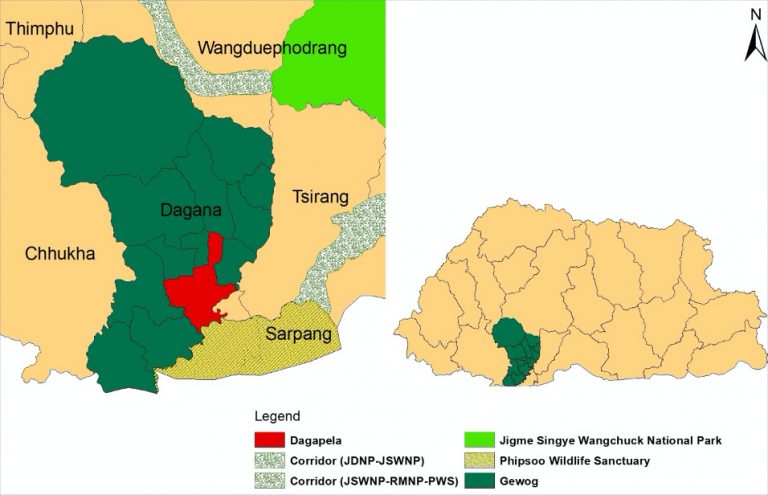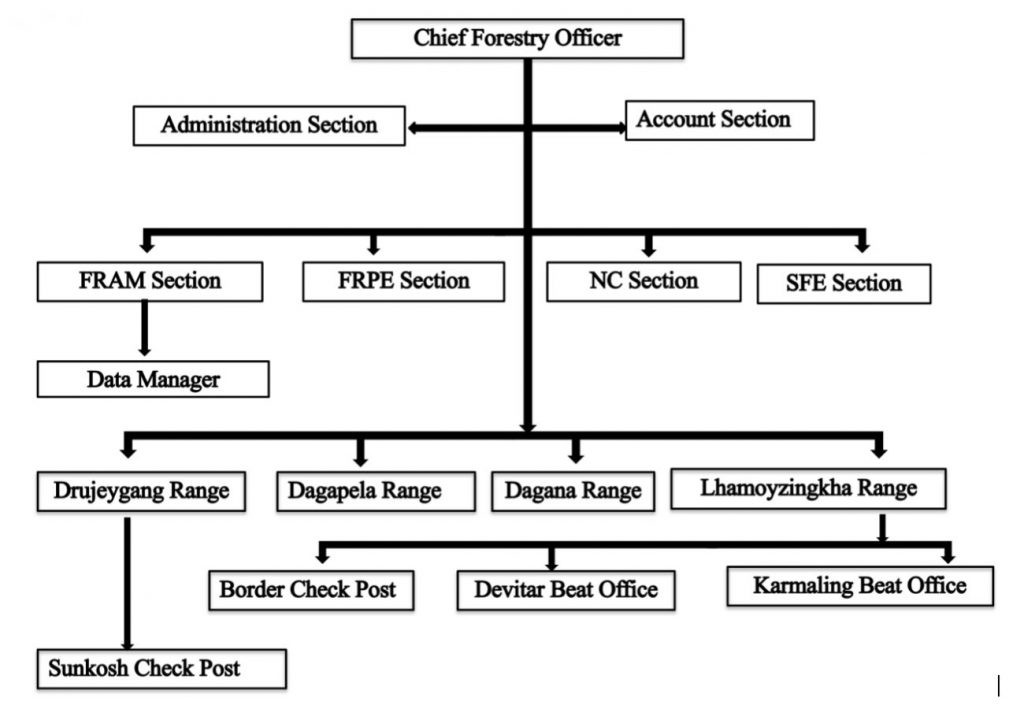Introduction
The Divisional Forest office of Dagana was established at Dagapela on 8th November, 2016 as per the order no. RCSC/PPD-40/2016/ 3686 dated 10th May, 2016 and the subsequent endorsement of the Dzongkhag Tshogdue held on 24th and 25th October, 2016. The establishment of the Division Office in Dagana was one of the results of the Organizational Development (OD) exercise carried out by the Royal Civil Service Commission.
Dagana Division covers an area of 1585.7 km2 encompassing 13 gewogs of the Dzongkhag. The area stretches from sub-tropical forest in the south to alpine forest in the north with an elevation ranging from 90 masl till 3800 masl. Dagana Division is bordered by Wangdue and Thimphu Dzongkhag in the north, Chukha Dzongkhag in the west, Tsirang district in the east and the Phibsoo Wildlife Sanctuary (PWS) and Indian State of West Bengal in the south. The strategic location of the Division plays a pivotal role in terms of the conservation of key flora and fauna species. Dagana Division is home to some of the critically endangered species such as Ardea insignis, Paphiopedilum fairrieanum and Manis spp. The division also harbors key fauna species including Panthera tigris, Elephas maximus, Tor putitora, Panthera pardus, Bos gaurus, Cuon alpinus and Axis porcinus and flora such as Taxus wallichiana and Gastrochilus calceolaris. The Division has four sections at the head office and four ranges office in the field to cater forestry services.
Administrative Setup
Organogram
Contact Address
- Head, FRAMS
Mobile no: 17979841
Email: ugyenten@moaf.gov.bt
- Head, FRPES
Mobile no: 17993473
Email: gtshewang@moaf.gov.bt
- Head, SFES
Mobile no: 17652148
Email: jgyeltshen@dagana.gov.bt
- Head, NCS
Mobile no: 17809228
Email: syangden@moaf.gov.bt
- Range Officer, Dagana Range
Mobile no: 77614041
Email: kenwangdi@gmail.com
- Range Officer, Dagapela Range
Mobile no: 17923255
Email: samharry12375@gmail.com
- Range Officer, Drujeygang Range
Mobile no: 17696731
Email: rangersonam1969@gmail.com
- Range Officer, Lhamoyzingkha Range
Mobile no: 17475115
Email: jigmewangchuk@cnr.edu.bt
TOR of Division
- Forest Resources Allocation and Management Section (FRAMS) Forest Resources Planning and Implementation:
- Provide technical support for identification of new potential area for establishment of Local Forest Management/other Forest Management Unit (FMU).
- Provide support for preparation of management plans/review and process for approval of management plans.
- Report ad-hoc timber extraction programs to NRDCL/DoFPS.
- Forest Resources inventory:
- Provide technical support (FMU and WS inventory) to Range Offices for preparation of management plans.
- Carry out data analysis of FMU/WS to estimate the growing stock.
- Coordinate and conduct periodic National Forest Inventory.
- Regulation of Wood Based Industries:
- Provide technical assistance for development of wood based industries.
- Carry out timber resources assessment and allocation.
- Implement rules/guidelines for timber resources marketing/distribution and disposal.
- Facilitate in registration of WBI/sawmill/power chainsaw/mobile sawmills and issue certificate of registration and renewal of certificate from time to time.
- G2C unit:
- Maintain forestry information database and disseminate the information.
- Coordinate RHBT & other G2C related task.
- Watershed/wetland Management:
- Carry out assessment of critical watershed/wetland for management interventions.
- Develop & operationalize PES from the watershed.
- Organize with relevant agencies to identify and prioritize and collaborate in activities contribution to watershed management.
- Forest Resources Protection and Enforcement Section (FRPES) Forest Litigation-functions such as;
- Deal with rule enforcement and legal issues (Court cases).
- Implement forestry Acts/Rules in line with other judiciary norms.
- Defend/represent the Division/Range against any civil & criminal accusation.
- Maintain and strengthen Uniform Code of Conduct within Division.
- Process Forestry Clearance:
- Issue FC for all type of activities such as surface collection/RBM/road, SRFL/Pvt. Land etc.
- Monitor and inspect all the activities related to issues FCs. 3. Forest Epidemics-functions:
- Provide general information on the common forest pests & diseases.
- Combat pest & disease problems in consultation with the DoFPS.
- Compile data on forest pest & diseases.
- Prepare remedial measures to prevent any outbreaks in consultation with the DoFPS.
- Anti-Poaching:
- Coordinate and mobilize staff to the sensitive place for patrolling/monitoring.
- Liaise and monitor forest check post.
- Compile and analyze anti-poaching reports.
- Adopt a “Programme Approach” to Anti-poaching in the Division.
- Organize sensitization workshops on Anti-poaching Programme for the field staff time to time.
- Monitor/manage arms, ammunition and handsets.
- Forest utilization
- Monitor approved RHBT utilization.
- Observe timber auction procedure & results thereafter.
- Oversee export/import of forest produce.
- Monitor forest produce utilization in Wood-based Industries.
- Forest land use
- Conduct site verification before or after FC issuance.
- Coordinate& monitor SRFL encroachment cases.
- Monitor waste management program.
- Forest fire management
- Design & implement a coordinated forest fire awareness program & enhancing people awareness about forest fire and other natural calamities.
- Develop a Divisional Fire Prevention Strategy&provide technical backstopping to the Range offices for effective forest fire management.
- Distribute basic forest firefighting equipment.
- Ensure training modules & impart training on forest fire fighting for armed force personnel.
- Liaise with media in informing & educating the public.
- Social Forestry & Extension Section (SFES)
- Community Forest and NWFP
- Carry out preliminary survey and joint verification on feasibility of CF/NWFP establishment.
- Facilitate CF/NWFP management planning in consultation with CFMG, annual work planning, mid-term review, monitoring and reporting.
- Carry out annual auditing of CF/NWFP activities.
- Resolve any type of conflict.
- Facilitate marketing of FC forest produce/NWFP.
- Private/institutional forest:
- Create awareness and initiation of Private/institutional forest program.
- Monitor and review of PF management plans.
- Afforestation/plantation.
- Conduct the joint identification and cost estimation of plantation site with GBCL.
- Process the technical sanction from DoFPS.
- Facilitate annual maintenance of plantation activities.
- Carry out timely monitoring and reporting.
- Nursery management:
- Conduct feasibility study.
- Facilitate for construction and maintenance of nursery.
- Monitor and report the progress.
- Social forestry:
- Organize social forestry day program.
- Nature Conservation Section (NCS)
- Species Conservation and Monitoring:
- Coordinate and collaborate to manage all activities related to conservation of biodiversity within the division.
- Identify species of importance, conduct surveys and frame conservation plans for the target species in collaboration with relevant agencies and institutions.
- Plan and compile data on biodiversity surveys for species of importance and share with decision and policy making body at local level.
- Develop grant proposal for section related activities.
- Ecotourism:
- Identify, develop and promote ecotourism products in consultation with concerned functional division.
- Liaise with NCD for identification of new potential area for establishment of heritage forest.
- Impart environmental education and awareness to encourage and increase the public support towards biodiversity conservation while sustainably utilizing the natural resources at division level.
- Human Wildlife Conflict Management:
- Liaise with relevant offices to identify and implement human-wildlife conflict mitigation measures at division level.
- Conduct public awareness program on HWC in conflict prone areas.
- Carry out regular monitoring of the various intervention measures implemented throughout the division in coordination with the range offices.
- Compile HWC data and reports from the field offices.
- Maintain HWC data of the division and submit as and when asked by the relevant functional divisions of the department.
- Coordinate to provide rapid response to the human wildlife conflict incidences within the division.
![]()



